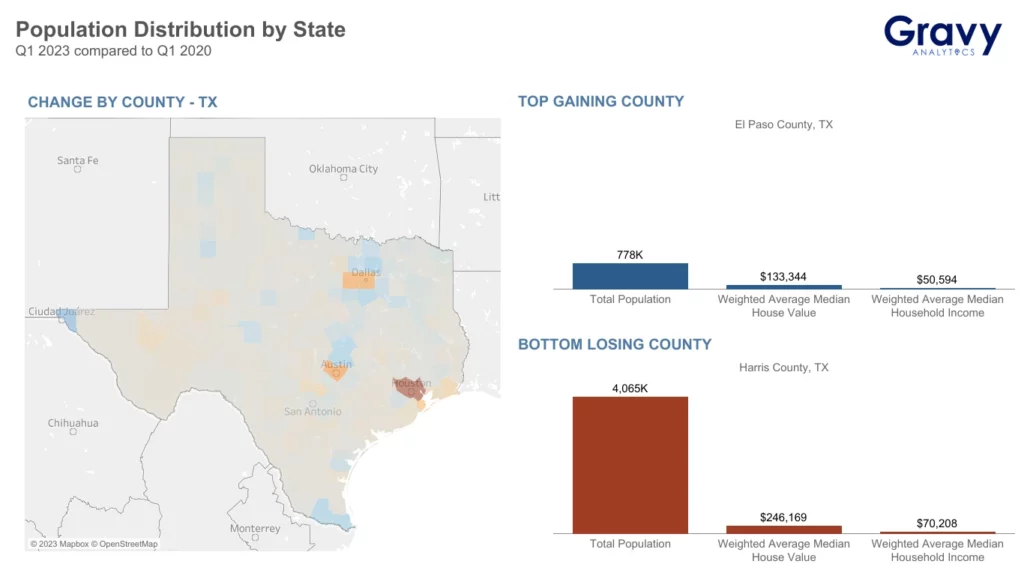Understanding Texas’ Population Shifts in 2023: Insights from Location Intelligence
August 3, 2023

Texas is the largest state in the contiguous U.S., and it is famous for its vast, diverse landscape, large cities, and cowboy history, fueling much of what we know as classic American culture. This helps make Texas the perfect destination for hundreds of millions of tourists every year. Not only are tourists heading to Texas, but new residents are fueling Texas’ growth as well. With over 30 million residents this year, Texas is not only a leader in U.S. culture but also in population size. With such large tourist and relocation numbers, consumer foot traffic in Texas can likely provide helpful insights into many consumer trends we see today. So, while the air of Southern hospitality may draw in tourists and new residents to the Lone Star State, we wondered what location data could teach us about Texas’ population.

To learn more about the unique state of Texas, we examined location analytics for the state from Q1 2020 to Q1 2023 in our recent report, “The State of U.S. Population Movement.” We took a look at how the population may be shifting in Texas counties for added insights into consumer trends in the state.
Texas’ Population Movement Trends
In our study, we analyzed location data signals throughout the state of Texas using our rich and reliable location intelligence. We process, cleanse, and prepare billions of location signals daily to ensure high quality, accurate, and privacy-friendly data insights, helping us peer into today’s consumer habits in the real world. This allowed us to properly and accurately determine how the population in Texas has shifted since the start of 2020. Here are our findings.
In Texas, El Paso County has welcomed the most new residents in the last few years. Home to El Paso, the 6th largest city in Texas, this is an extensive trade territory with a diversified industrial structure, helping this area become one of the country’s largest centers for manufacturing. Along with El Paso County, Cameron and Hidalgo counties, next to the Gulf of Mexico and along the Mexican border, also saw population growth. In the Dallas area, Collin County placed second in population growth since Q1 2020.

On the other hand, there were also many counties in Texas that experienced population losses since the start of 2020. Harris County, where the city of Houston is located, saw its population decrease more than any other county in the state of Texas. Similar to Miami-Dade County in Florida, Harris County is the most populous county in Texas, regardless of its recent fall in population. However, Harris County wasn’t alone in losing a significant amount of population in the last few years. Travis County, in the Austin area, saw population loss, along with Tarrant and Dallas counties.
So, why have residents from some of the most populous metropolitan areas in Texas left while other counties are welcoming new residents?
Housing Costs & Other Consumer Trends
Overwhelmingly, we’ve seen that housing costs have been one of the major driving forces impacting recent state population movement. There are other factors to consider, such as international migration, which is likely impacting El Paso County and its population growth. However, in our study, we identified a strong trend of many Americans, including Texans, relocating to areas with lower average housing costs. For example, in Texas, the weighted average median house value in Harris County is $246,169, while in El Paso County, it’s $133,344.
In El Paso County, the city of El Paso has some of the lowest housing costs in the state of Texas, at 10% lower than the national average. This is likely a key factor in attracting new residents to the growing population of El Paso County.
To learn more about how this trend can also be seen in the state of Florida, read our recent blog post that dives into some of the details.
Population Distribution and Foot Traffic in Texas
While there are many areas losing significant numbers of residents and other areas gaining, the state of Texas has seen overall population growth in recent years. In fact, Texas is one of the nation’s top growing states.
With a strong workforce of 15 million and counting, Texas leads as one of the nation’s top states for economic growth as well as population growth. The economy in Texas is diverse and flourishing, which may be helping the state’s population increase. Why is this important? Texas has a unique and unevenly distributed population, booming in some areas and diminishing in others throughout the state. So as the economy continues to flourish, uneven expansion may continue as well, which may make for uneven consumer foot traffic in Texas. There could be large areas with increasing foot traffic to businesses in Texas, and other areas that struggle to attract visitors. Some areas may see consumer foot traffic to plants or factories for manufacturing, while other areas may experience more traffic to small businesses. It is important for businesses in vast areas like Texas to understand how and why the population is growing in some areas and declining in others. This can help businesses build a better understanding of consumer wants and needs as well as consumer habits that may impact foot traffic trends.
For example, in bustling metropolitan areas in Texas, commute times are notoriously long. How could this be impacting consumer foot traffic to surrounding commercial areas of interest, and how could commute or dwell times at public transportation centers lead to relocations or changes in daily routines? These insights are important not only for businesses but also for governments, transportation, housing development organizations, and more.
Our Population Movement Study
These state insights come from our recent report on the current distribution of population across the country, which examined the impact of various factors on population movement trends. Our reliable location data allowed for accurate consumer insights and interesting findings on the current population of Texas.
Learning about these population movement patterns over time can help us better understand consumer needs, desires, and preferences. These insights can also help organizations better prepare for any future population movements. By understanding what drives people away from certain locations and what draws them into new ones, researchers can anticipate movement patterns that may impact businesses in the future and maintain a real-world understanding of customer needs. Furthermore, insights like this can inform decisions for site selection, transportation, and even location-based marketing strategy, among many other things.
Download the full State of U.S. Population Movement report today for more information about our methodology, our data, and our findings in this population movement study.




